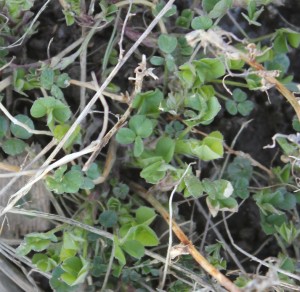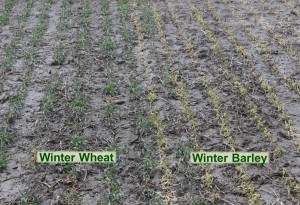Conditions: More rainfall in region south and east of Ottawa over the April 12th weekend. Fields are generally saturated. Upper Ottawa Valley has drier conditions. Moisture from snow melt got away with very little ponding in most areas.
Alfalfa: Winter survival looks good to date. Alfalfa has 2 to 3 inches of new growth at this point with no/minimal heaving of the plants and healthy roots and crowns.
Discussion around rolling alfalfa plants to push-in slightly heaved crowns/roots. This practice is not recommended as it would cause significant damage to alfalfa crowns. For more information see Frost Heaving of Alfalfa by Joel Bagg, OMAF/MRA. Forage inventories are good; much better than at this time last year. A few of the weaker forage stands will be harvested at first cut and then seeded to either corn or soybeans.
Winter Wheat: Acreage in the far eastern part of the province has increased over the last year. A few growers have switched from spring wheat to winter wheat. Winter survival looks good at this point. Plants are greening up. Pictured below is a trial of Winter Cereals for Forage with 2 varieties of winter triticale, winter wheat, cereal rye and winter barley planted September 30 2013 at the Winchester Research Farm. Even the winter barley has survived, albeit not as robust as the other species.
Very little nitrogen has been applied to date. Some red clover has been broadcasted. Note: Growers should be aware that Agricorp/Crop Insurance has coverage for establishment protection of red clover, see New Forage Seeding Plan.
Spring Cereals: Over the last few weeks demand for spring wheat seed picked-up. There has also been some interest in barley seed. Only a few growers are planning to grow for malting barley.
Corn: A few growers are switching a portion of their intended corn acreage to soybeans, but overall the acreage switch is small. Growers with corn in stored on-farm should monitor bins for grain moisture. Recently a few loads have been rejected at the elevators due to high moisture. Fertilizer supplies are adequate.
Soybeans: The slight shift upward in soybean acreage is the result of commodity pricing and acreage not tilled last fall. Soybean seed supply good. Supply of some brands of inoculant may be tight. IP Soybean growers should check with their buyers to see which pesticides are permitted under the contract.
Seed Treatments: Reminder on the use the Fluency Agent when a seed lubricant is needed. For more information see Bayer Fluency Agent – Facts for 2014 Planting Season by Tracey Baute OMAF/MRA.
Weed Resistance: Herbicide resistance test results for the samples collected in the fall 2013 were reviewed. The majority of the samples submitted tested positive for resistance to Group 2 herbicides (eg. Pursuit, Classic, Pinnacle, etc.). Weed species resistant Group 2 herbicides were common ragweed, green and giant foxtails, lamb’s quarters, green pigweed and eastern black nightshade. Five weed species (pigweed, common ragweed, lamb’s-quarters, green foxtail and giant foxtail) from one field tested positive for resistance to Group 2 herbicides, with one of the five species (lamb’s-quarters) also being resistant to Group 5 herbicides (eg. Aatrex). For more information see 2014 Herbicide Resistant Testing Results – University of Guelph by Mike Cowbrough OMAF/MRA.
Crop Insurance/Agricorp Update: The Forage Rainfall program has increased coverage from $300 to $600 per acre. May 1st is the deadline to apply or make changes to Crop Insurance for 2014 crop season. There has been an increase interest from producers for strawberry coverage in the area.
Next meeting:
7:30 am, April 29th, Country Kitchen Restaurant, Highway 31, Winchester, ON.
Important Dates:
July 9 and 10 – Ridgetown Diagnostic Days
July 15 – Eastern Ontario Crop Diagnostic Day, Winchester Research Farm.
July 17 – FarmSmart Expo, Elora Research Farm

